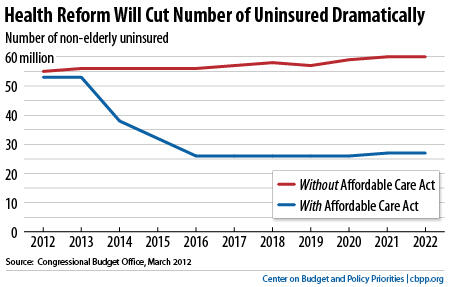BEYOND THE NUMBERS
Part 1 of this series looked at some of the benefits that the Affordable Care Act — that is, health reform — has delivered in just its first two years. But some of the law’s most dramatic improvements to both the health care system and the lives of tens of millions of people lie ahead.
- Health coverage for tens of millions of the uninsured.
Thirty-three million uninsured people will have health coverage by 2022 because of health reform, according to the Congressional Budget Office (see chart). Research studies consistently show that having health insurance enables people to get more health care services and improves their health.Image
- More affordable insurance for those who already have it.
Starting in 2014, many people who now struggle to afford health insurance will get help paying for premiums and out-of-pocket costs (like co-payments for doctor visits). This help will come in the form of tax credits and help with cost-sharing for private coverage that people buy through the new health insurance marketplaces, called exchanges, that health reform will establish for each state.Many states are forging ahead with setting up their exchanges and are well-positioned to have their exchanges operating by the January 1, 2014 target launch date.
- More protections for consumers.
Health reform has already banned some of insurance companies’ worst practices. But, more protections are on the way.Starting in 2014, it will bar insurance companies from denying coverage to anyone with pre-existing health conditions (the law’s current ban applies only to children). This means that people who previously couldn’t buy health insurance at any price because they had cancer or had had a relatively common procedure such as a c-section will be able to buy insurance and get the care they need.
Insurers also won’t be able to charge higher premiums to women or sicker people and will face restrictions on their ability to charge older people more.
- Steps to begin slowing the growth in health care costs across the economy.
Rising health care costs are putting pressure on the budgets of families and businesses, as well as public programs like Medicare and Medicaid. Health reform makes important progress in this critical area by significantly improving Medicare’s long-term financial outlook and taking a number of steps to lower costs and improve the quality of care by beginning to change the way providers deliver health care.
